GSCM Practices: Drivers and Adoption
Canadian manufacturers view high cost of energy andthe need to be competitive as the main drivers forimplementing GSCM practices in distribution activities(Figure 1). Other pressures, such as compliance withregulations, a desire to be a market leader, and accessto foreign markets are also important factors drivingbusinesses to consider implementing GSCM practices.1To make GSCM initiatives successful in the manufacturingindustry, environmental benefits and positive NetPresent Value (NPV) for the firm must also be achieved.2
Figure 1: Main drivers for implementing GSCM practices in distribution activities 1
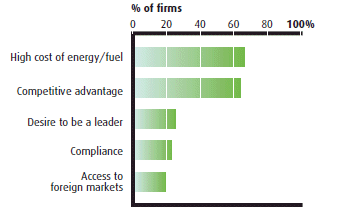
GSCM is viewed as strategically important by 92 percentCanadian manufacturers (Figure 2). But despite the large number of businesses that understand the importance of GSCM, the number of firms that actually engagein such practices is significantly lower. Only two out of three manufacturers actually implement GSCM practices in their distribution activities.1
Figure 2: Perspectives on and use of GSCM practices in distribution activities 1
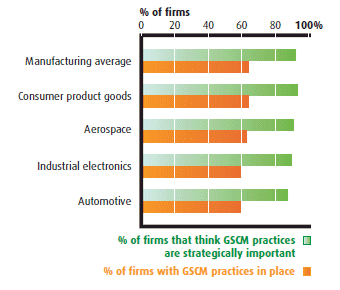
Firm size may no longer influence whether GSCMactivities are pursued. In the past, more large– and medium–scale Canadian businesses were engaged in GSCM practices. Recently, however, a greater numberof small–scale businesses have begun to initiate GSCM practices, catching up with larger firms (Figure 3). Since many GSCM practices require limited investment, are low–risk, and offer short–term return–on–investmentperiods, businesses of all sizes are able to engage in these activities.2
Figure 3: Use of GSCM practices in distribution activities — Business size 1
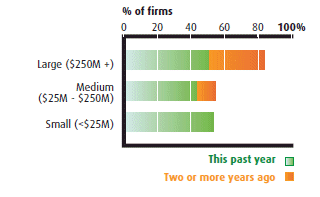
GSCM practices can be applied at different points in the distribution supply chain, either within the organization or in collaboration with customers and suppliers. Manufacturers are implementing most GSCM practices within their own organizations — a less complex solution thandeveloping a whole supply chain approach. The most common GSCM practice is implementing energy efficient improvements in distribution activities, such as the use of low–voltage conveyors and motion detector lights in distribution centres (DCs).1
A smaller number of businesses are engaging in these practices in collaboration with their customers andsuppliers (Figure 4). This consistent difference across practices indicates that manufacturers are focusingmore on improving their own activities at the initial stage of GSCM.
Figure 3: Main GSCM practices implemented in distribution activities 1
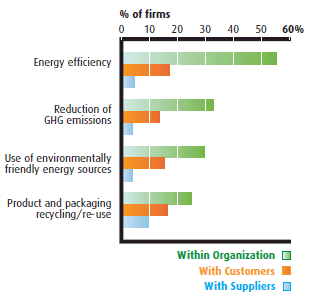
Another common GSCM practice is to reduce GHG emissions in distribution activities. Manufacturers canparticipate in a program where carbon credits are granted according to the amount of GHG that a businessemits in its operations, and unused credits can be sold to other companies.
In addition, some manufacturers are reducing GHG emissions by implementing a GSCM scorecard indistribution activities.Footnote III Not only does this emphasize a business's environmental commitment, but it can also be used to assess supply chain partners' environmentalimpacts and improvements. Companies that have used this process have noted considerable reductions in theirwaste, packaging material, and carbon emissions. This has led to significant savings in distribution costs, aswell as a general decline in carbon emissions.2
The adoption of GSCM practices within organizations is similar across manufacturing sub–sectors, but differs widely in the area of collaborative applications with customers. As a result of retail chain GSCM mandates in distribution activities, close to six times as manyconsumer product goods (CPG)Footnote IV manufacturers haveengaged in GSCM practices with their customers (retail chains) than have automotive, aerospace, and industrial electronics manufacturers (Figure 5).
Figure 5: Main GSCM practices implemented in distribution activities with customers 1
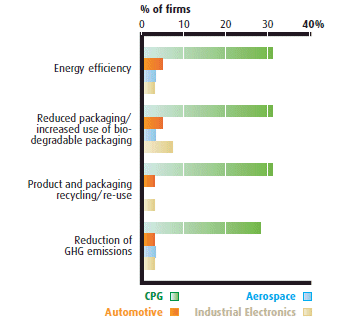
If past experience holds true, where non–CPG industrial sectors followed the retail sector's lead in introducinginnovation mandates (such as Electronic Data Interchange), these sectors are then expected to initiateGSCM mandates with their suppliers in the coming years.2
Footnotes
- Footnote 3
A GSCM scorecard refers to the use of metrics to evaluate the evolution of specific key performance indicators.
- Footnote 4
CPG manufacturers are companies that design, manufacture, and market apparel, food, jewellery, dolls, toys, games, cleaning products, hand and power tools, home furniture, housewares, sporting goods, linens, and consumer electronics and appliances.
